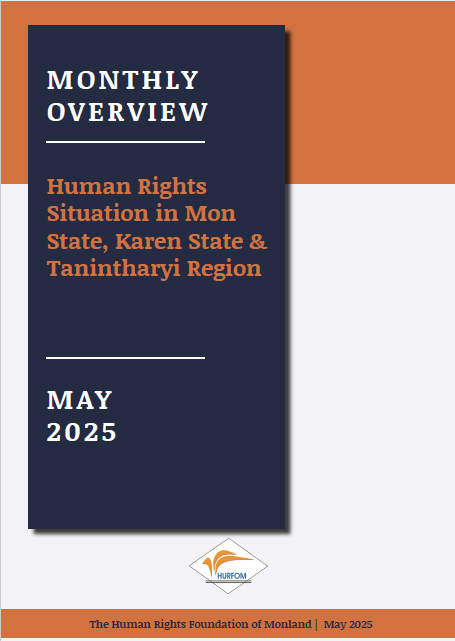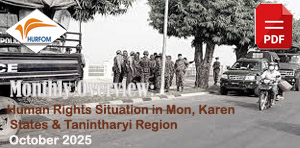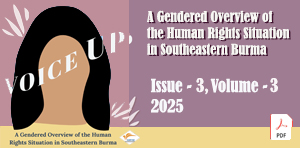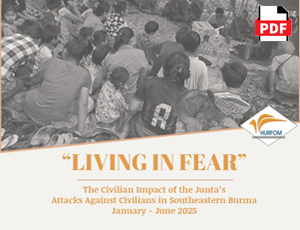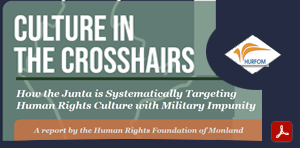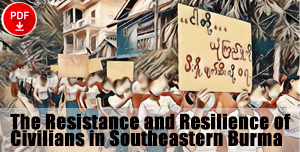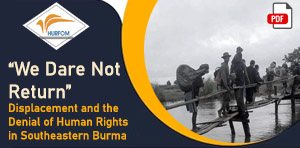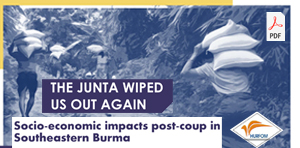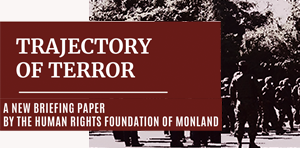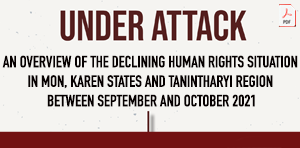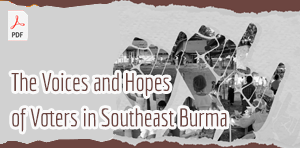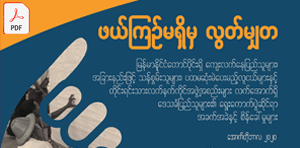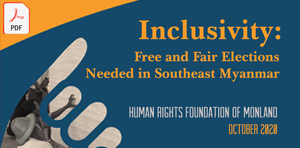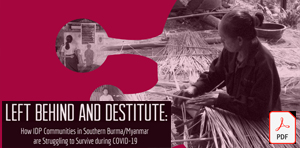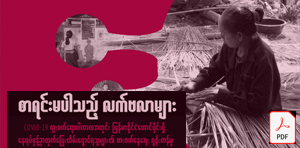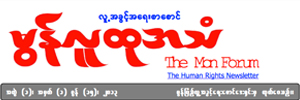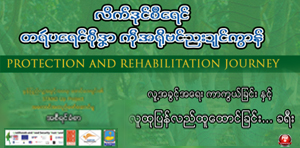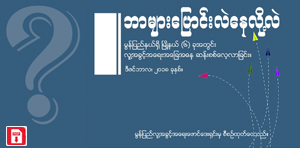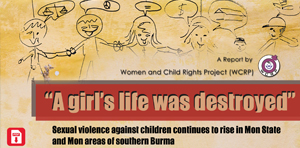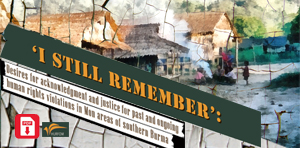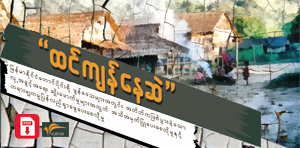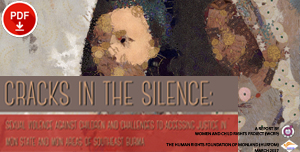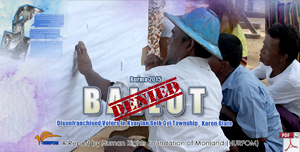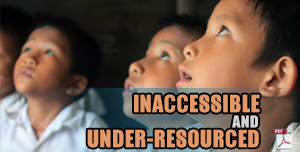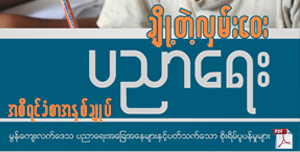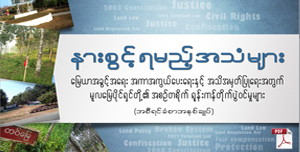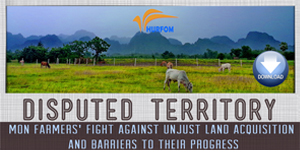Monthly Overview: Civilians in southeastern Burma Face Daily Threats to their Survival as the Junta Bombards Local Areas with Air and Ground strikes, Despite the So-Called Ceasefire
June 2, 2025
In the last month, in targeted areas of the Human Rights Foundation of Monland (HURFOM), including Mon State, Karen State, and the Tanintharyi region, civilians have faced a constant barrage of attacks by the military junta. Following the regime’s own ceasefire, which was announced after the March 28th earthquake and extended to May 31st, a series of brutal assaults nationwide have left innocent villagers gripped with fear, grief, and trauma, as children, young women, and youth make up the majority of the casualties.
The Karen National Union (KNU) has strongly condemned the junta’s recent “ceasefire announcement,” calling it a deceptive move intended only to attract humanitarian aid flows through Naypyidaw while continuing brutal attacks on civilians. In a statement released on April 26, 2025, the KNU accused the junta of deliberately targeting civilian populations in towns and villages controlled by resistance forces, despite their ceasefire claims.
The KNU’s statement described the junta’s actions using a powerful idiom often referenced in Burmese politics: “hanging a goat’s head while selling dog meat” — accusing the junta of promoting peace on the surface while committing relentless violence in reality.
Between April 2 and April 22, 2025, during the junta’s supposed unilateral ceasefire, the KNU documented violations revealed that the junta carried out at least 110 separate human rights abuses across KNU-administered areas. These included:
- 63 aerial bombings using fighter jets, helicopters, and drones, resulting in the deaths of 14 civilians and one novice monk, injuries to three monks and 34 civilians, and the destruction of five monasteries and seven homes.
- 43 artillery attacks, killing five civilians, injuring 18 others, and damaging at least 16 houses.
- The deliberate burning of homes and religious buildings, with four homes and one pagoda destroyed by arson.
- The arbitrary arrest of two civilians and landmine injuries to another two civilians from junta-planted explosives.
The KNU emphasized that, far from seeking genuine peace, the junta is engaging in false and deceptive practices to manipulate the international community, donors, and humanitarian organizations.
“They have weaponized humanitarian aid, aiming to route all assistance through their control while continuing to kill and oppress their own people daily,” said a former Mon politician from Mawlamyine.
“Since their military coup, and even after disasters like the Sagaing earthquake, the junta’s priority has not been the welfare of the people, but legitimizing their rule and preserving their power.”
He further stressed that international leaders, ASEAN members, and global donors must recognize the junta’s tactics and stop legitimizing the military regime through aid channels they control.
Meanwhile, on April 26, 2025, junta forces launched yet another aerial attack on Kanni Village, Kyon Doe Town, Kawkareik Township, Karen State. Despite no fighting in the area, a junta drone dropped a bomb directly onto a civilian home, seriously injuring a 50-year-old male resident whose leg had to be amputated. He is currently receiving urgent medical care.
This marks the third time the junta has deliberately bombed Kanni Village civilians without any active clashes, exposing a ruthless and escalating pattern of violence since the Burmese New Year period. Reflecting on the worsening crisis, a humanitarian worker from Brigade 6, providing relief in Karen areas, said:
“The crimes committed by the junta against innocent civilians must be brought before the International Criminal Court (ICC). No dictator escapes justice forever. It is time for international leaders, including ASEAN, to stop working through junta-controlled channels. Instead, they must directly support community-based organizations, ethnic service providers, and civil society organizations who genuinely serve the people on the ground.”
The calls for accountability and a shift in international humanitarian strategy are growing louder as the junta’s systematic abuse of civilians continues unchecked. The indiscriminate nature of the junta’s attacks highlights the failure of the international community to hold them accountable for the violent and systematic crimes committed against innocent people. As documented by HURFOM and many other civil society organizations, most attacks against local civilians are unprovoked and target crucial infrastructure, including schools, clinics, and hospitals, where villagers attempt to redeem some sense of normalcy amid daily attacks that occur without warning.
The ongoing funding cuts and reductions in donor funds have also led to crippling levels of anxiety and uncertainty for refugees and conflict affected groups who are barely surviving. The humanitarian crisis facing communities on the ground along the Thailand-Burma border has reached a critical point. In an urgent joint appeal, 20 core Karen organizations—including civil society groups, ethnic health providers, and refugee service networks—are calling on the international community to respond immediately to life-threatening aid cuts that are affecting more than 108,000 people living in displacement camps.
Despite months passing since the initial attacks, more than 5,000 displaced villagers from six communities across Bilin and Kyaik Hto Townships remain unable to return to their homes, citing daily aerial threats and surveillance by junta forces.
Displaced families from Min Saw and Tagaylaung villages, among others, continue to shelter in territories controlled by Ethnic Resistance Organizations (EROs), too fearful to go back due to frequent flyovers by junta spy aircraft and drones. Field reports confirm that access to food, safe shelter, and necessities has become increasingly difficult, especially with the onset of the rainy season fast approaching. Many internally displaced persons (IDPs) face not only physical displacement but also emotional trauma, as fears of sudden attacks loom over them daily.
According to a 56-year-old Karen villager displaced from Min Saw:
“The last major aerial attack occurred on April 19, 2025, when the junta bombed Min Saw village in the Tagaylaung village tract of Bilin Township. This was the second time the area was targeted — the first attack was on February 9, 2025, when a junta jet fighter dropped a 500-lb bomb, damaging a monastery, homes, and killing civilians.”
Due to these repeated assaults, more than 2,600 residents from the Tagaylaung village tract, which had over 700 households, have fled to ERO-controlled territories and remain displaced. Similarly, in Kyaik Hto Township, survivors from villages around Painae Gone have been unable to return home since an aerial attack on February 13, 2025. More than 2,400 civilians from three nearby villages remain displaced. A local service provider explained:
“The junta dropped 500-lb bombs, killing three civilians and injuring at least ten others. Since then, junta aircraft continue daily aerial surveillance over Min Saw and Tagaylaung villages, making it impossible for people to feel safe enough to return. Families are struggling to survive in makeshift shelters.”
Another local volunteer, herself an IDP, shared:
“At first, building shelter was already difficult. We had to rely on bamboo and thatch to build small huts. Now, with the rainy season approaching, it will only get harder. The junta’s constant air threats make it impossible to farm or rebuild our lives. Humanitarian aid is also extremely limited. We don’t know how we will survive the coming months. We can only pray that our children won’t fall sick when the rains bring new diseases.”
Most IDPs sheltering KNU’s Brigade 1 areas were formerly self-sufficient farmers, rubber plantation workers, and small-scale livestock owners. Before the military coup, they lived stable lives in their home villages. However, since the coup and escalating military offensives, they have become victims of relentless aerial bombings and indiscriminate artillery attacks.
An Emergency Response Team member working with displaced communities reflected:
“If we cannot work safely or live securely, we cannot sustain our lives here in the long term. The junta’s military pressure grows stronger every day, and even now, we haven’t found a truly safe place to rebuild our futures.”
The situation in Bilin and Kyaik Hto Townships highlights the ongoing humanitarian catastrophe facing thousands of civilians in southeastern Burma, with urgent calls for increased international support to reach displaced communities before conditions deteriorate further.
Refugees already facing insecurity and food shortages are now being told to survive on daily rations worth as little as 5 to 10 US cents. For children under five, monthly food allocations have dropped to just 53 Thai Baht (about $1.50). It’s just 87 Baht (around $2.40) monthly for adults—barely enough for survival. These cuts have been driven by long-term funding reductions from major donors, including the United States.
Meanwhile, in areas across Burma where many of these refugees originate, junta forces continue to escalate their military offensives. Communities in Kawkareik, Bilin, Kyaik Hto, and Dawei townships have come under near-daily assault through brutal airstrikes, indiscriminate artillery shelling, and other forms of aerial attacks. HURFOM field reports have confirmed widespread displacement, fear, and destruction in these areas.
In Kawkareik Township, for example, junta battalions have repeatedly targeted civilian zones with no ongoing clashes. Entire towns have been emptied overnight due to fear of incoming shells. Meanwhile, humanitarian convoys are blocked from reaching those most in need, and security concerns continue to mount along key roads such as the Union Highway in southern Burma. On 13 May 2025, HURFOM also released a statement condemning the ongoing violence against innocent civilians and calling for an urgent response to the widespread and systematic atrocities committed by the junta, as well as for locally-led humanitarian aid pathways.
The junta’s alleged ‘ceasefire’ has also been violated in the Tanintharyi Region. Junta forces launched three consecutive days of aerial bombings on civilian areas in Thayet Chaung Township, Tanintharyi Region, despite no active clashes occurring in the targeted villages. At least one civilian was killed and multiple others injured during these unprovoked attacks, according to residents.
One of the most recent bombings occurred on April 29, at approximately 12:48 PM, near the entrance sign of Kyauk Kha Mauk village, where a bomb dropped close to a local noodle shop. A man in his 40s was killed instantly, while Ma Mee Kam (age 47) and her teenage daughter were seriously injured. The victims were civilians with no affiliation to armed groups. Locals confirmed that the man who died was visiting from a nearby village.
A young woman from Kyauk Kha Mauk told HURFOM:
“These bombings are happening in villages where there is no fighting at all. For the past three days, they’ve sent fighter jets to drop bombs and follow up with machine gun fire. People are injured, and the situation is terrifying. Our village has no clashes, but we’re being targeted anyway.”
Local sources confirmed that Kywe Min Gone, Kyauk Kha Mauk, Yangae, and Chauk Chaung villages were bombed during this period. Bombings also reportedly struck Kywe Min Kone Junction, Kwe Min Kone, and Chaung Chaung villages, as well as Kwe Chan, Kamyaing, and Win Kaphaw villages—all located far from active conflict zones.
Although a clash did take place on April 18 between junta troops and resistance forces, including the Karen National Liberation Army (KNLA) and People’s Defense Forces (PDF), these recent airstrikes were carried out in areas not involved in the conflict.
According to HURFOM’s documentation, the Winwa Security Base, a major junta outpost along the Dawei–Myeik highway between Sinku Village and Palauk Town, has been under pressure from drone and ground attacks by resistance forces since early April. Despite this, junta forces have increasingly expanded their aerial and artillery assaults beyond the immediate conflict area.
Between April 19 and April 29, the following airstrikes were confirmed:
- April 19: 1 airstrike
- April 21: 2 airstrikes (midday and 10:30 PM)
- April 25: 2 airstrikes (9:30 AM and 11:30 AM)
- April 27: 1 airstrike
- April 28: 1 airstrike
- April 29: 1 airstrike
These attacks impacted both the direct surroundings of Winwa Base (including Winwa, Thae Chaung Thar, and Minn Dat villages) and remote villages unrelated to active combat. As a result of continued airstrikes and fighting in the region, the Dawei–Myeik highway has now been closed for 12 consecutive days, cutting off movement and access to essential goods. Displacement is rising, with many villagers from southern parts of Thayet Chaung Township fleeing their homes to seek safety in nearby forests or ERO-controlled areas.
Similarly, in Mon State, attacks once again served as further evidence that the junta lacks the capacity to adhere to any type of agreement that includes a cessation of violence, including its ceasefires. Field documentation teams have confirmed that starting from the last week of April, junta forces escalated both artillery shelling and aerial bombings across several villages located between Kyaik Hto Township in Mon State and Shwe Kyin Township in the Eastern Bago Region. These attacks targeted areas without active fighting and caused multiple civilian injuries and mass displacement.
According to local monitors, a clash broke out on April 23 between the junta. It combined Karen National Liberation Army (KNLA) troops near Kwin Seik Village in Shwe Kyin Township, Eastern Bago. Following this, junta forces indiscriminately shelled and bombed several nearby Mon State villages, including Kha Ywe, Pyin Kadoe, and Painnae Gone, as well as villages in the conflict-adjacent zone — Nyaung Chay Htauk and Win Kan.
At approximately noon on April 23, the Artillery Regiment Command No. 310, based in Kyaik Hto, fired at least nine artillery shells toward the area surrounding Khaywe Village.
“The shells landed across our village — two in the Mon Su section, three near the football field, and four just outside the village. The fighting had just happened earlier that day in Shwe Kyin, but we had no time to escape before the shells started falling. Two people from our ward were hit,” said a resident from Khaywe Village.
According to witnesses, two civilians from the Mon Su section of Khaywe, Ko Chat Gyi (age 34) and Daw Moe (age 47), were seriously injured by shrapnel from the shelling. The artillery attacks forced approximately 500 villagers from Khaywe to flee. Most have sought safety in makeshift bomb shelters or nearby forested areas, according to local accounts.
Displacement was also reported across the Sittaung River on the Eastern Bago side, where civilians from the affected villages in Shwe Kyin Township began fleeing to safer locations. On the Mon side, residents from Kyaik Hto have been fleeing toward Theinzayat town and the surrounding areas. Preliminary data suggests that more than 4,800 people from at least ten villages in Shwe Kyin Township — including Kwin Seik — have now been displaced due to recent fighting.
“There’s fighting all along the eastern side of the Sittaung River. At least 1,000 IDPs have already arrived in Theinzayat town, and more are coming every day. Most are sheltering at monasteries,” said a resident of Theinzayat.
Displaced villagers now living in Theinzayat are taking refuge in monasteries or staying with relatives. Many urgently need humanitarian support, including food, clothing, and medical care. Locals report that the conflict zone is widening along the Shwe Kyin–Theinzayat road and expanding eastward to the banks of the Sittaung River, suggesting that the number of displaced families may continue to rise in the coming days. Though some IDPs are managing for now by selling personal belongings they carried with them, aid workers warn that long-term support will be essential, as basic needs grow and resources dwindle.
In yet another tragic incident of violence against civilians, the military Junta launched an artillery attack on Pandeik Kone village, part of Kadipu village tract in Bilin Township, Thaton District, Mon State. On the night of May 21, 2025, between 8:18 and 8:20 PM, two 120mm mortar shells exploded in the village, causing multiple casualties among residents.
According to HURFOM’s field documentation and local eyewitnesses, Ma Aye Naing, 48 years old, the daughter of U Aik Bone, was killed on the spot due to the blast. Mi Nu, also 48 years old and the daughter of U Toe Tat, sustained serious shrapnel injuries to her right side. A young girl, Ma Khin Pa Pa Lin, aged just 11 years old, the daughter of U Bo Naing, suffered a direct wound to her right thigh.
These attacks occurred despite there being no clashes in the area at the time, pointing again to the Junta’s continued pattern of indiscriminate targeting of civilian populations. The use of heavy artillery in residential villages like Pandeik Kone is part of a growing trend this month, where HURFOM has documented an alarming increase in artillery attacks, drone strikes, and airstrikes across Mon, Karen, and Tanintharyi Regions.
Throughout May 2025 alone, HURFOM has confirmed over 110 artillery and air attacks, resulting in at least 25 civilian deaths and dozens more injured, including children, women, and elderly villagers. Entire communities are being terrorized, with thousands forced to flee for safety into forests and makeshift shelters, where they are exposed to hunger, illness, and trauma.
“These repeated attacks on villages where no fighting is taking place show a heartbreaking disregard for innocent lives,” said a human rights defender working with HURFOM’s field monitoring team. “The junta is using fear and violence to control the population, and these actions are clear violations of international humanitarian law. This kind of impunity cannot continue. We urgently need stronger efforts to hold them accountable, increased cross-border aid and real protection for survivors and their families.”
Local humanitarian workers in Bilin Township, located in KNU Brigade 1 territory, also call on the international community to respond swiftly and decisively. They emphasize that the needs on the ground are growing daily and that immediate support is critical to saving lives and restoring dignity to those affected.
Forced Conscription
Young men in Ye and Thanbyuzayat Townships are being targeted in increasing numbers by junta forces through aggressive “stop-and-frisk” operations and arbitrary arrests, according to HURFOM field documentation teams. These abuses appear to be part of a systematic campaign to extort, abduct, and forcibly conscript civilians as the junta struggles to replenish its declining troop numbers.
Since early April, reports from locals have described daily military checkpoints at market areas, road junctions, tollgates, and hidden checkpoints within junta-controlled areas. Civilians—particularly young men—are being stopped, searched, and harassed without cause. Soldiers routinely demand bribes, abduct individuals, and pressure families to pay ransom fees for their release. Those who cannot afford the demands risk being sent to military training camps against their will.
On April 25, a witness reported heavy junta security near Ye Town’s entrance. “At the Mawkanin Road checkpoint, Light Infantry Battalion 106 stopped all vehicles. I saw four young men taken away that morning—two of them were later released after their parents paid 3 million kyat each. The other two, from Sonnathar village, were sent to Waekali military training camp,” said a 45-year-old rubber trader.
Others described similar experiences. A former member of the New Mon State Party said:
“I’ve seen at least three cases myself. In one, eight young men from Taung Phaloot and Kyar Kan were detained just for riding together on a motorbike. The military demanded 1.5 million kyat each. Once paid, the soldiers told them not to speak a word and released them.”
This pattern of corruption and coercion is intensifying in Ye Township. On April 26, a local woman from Abaw village shared her story:
“They stopped a woman over a single illegal lottery ticket and demanded 500,000 kyat. It wasn’t even the army—Pyusawhtee militias were involved too. For young men, especially those with prior drug-related records, they’re constantly being targeted. They get accused without evidence, and the families are forced to pay.”
Reports also confirm that junta forces are exploiting stop-and-search operations as a revenue source. “It’s a daily scam,” said a motorbike driver from Ye. “If two men ride together, they’re stopped and harassed. At checkpoints near Ye, police, military, and Pyusawhtee militias all take part.”
Even non-local travelers are at risk. At the Kyon Paung Road entrance to Ye Town, two young men were stopped, their motorcycle seized, and both were taken away without charges.
A local from Thanbyuzayat Township explained:
“They don’t follow any procedures. They pull men off bikes, force them to kneel on the ground, and check their bags and phones out of sight. If they want, they can plant drugs or anything else. No one can prove otherwise. This turns every checkpoint into a gateway to forced military training—or worse.”
On April 28, around 20 motorbikes carrying two men each were reportedly stopped at Chaung Taung Bridge. The exact fate of those detained remains unknown. According to several field sources, many of the abducted are being sent to military camps in Waekali and Pulaw Townships. These include Training School No. 12 and No. 4, notorious for forcibly enlisting civilians.
As noted by a rights activist and member of the Human Rights Educator Network based in Mawlamyine:
“The junta has turned its conscription law into a strategy to compensate for its battlefield losses. But in practice, it is weaponizing fear and treating its people as disposable. What we’re witnessing in Ye and Thanbyuzayat is not just arrests — they are crimes against humanity. These young people are being stripped of their freedom, dignity, and their right to life.”
In Mon State, the military junta and its appointed local administrators are ramping up efforts to forcibly recruit civilians and extort money under the pretext of military conscription. These actions are tied to the regime’s plan to launch the 13th round of People’s Military Service training, with local authorities across townships beginning to collect money from individuals through coercion.
Following the enactment of the junta’s conscription law, residents of Mawlamyine, Paung, Mudon, Thanbyuzayat, Kyaikmayaw, Ye, and Kyaik Hto townships report an uptick in street-level arrests targeting young men. Junta-aligned forces are detaining youth in both public spaces and private homes — often at night — and sending them to military training camps, citing “security concerns.”
A resident in Mawlamyine described events on the morning of May 1:
“They went door to door in some neighbourhoods collecting money for the 13th round of military training. Local administrators held community meetings in certain areas, saying households must either send a recruit or pay MMK 10,000 for some homes, and up to MMK 20,000 for others. The quarter and village tract leaders are pressuring people aggressively.”
Many locals describe this forced payment scheme as arbitrary extortion. Those who do not comply, especially youth within the eligible age range, are threatened with immediate enrollment. Some communities have received verbal warnings that those refusing to “volunteer” will be summoned and forcibly taken.
Field sources confirm that those being conscripted include people arrested at night, street detainees, suspected drug users, and others coerced into service through local administrative networks. Youth have sometimes been handed over as part of quotas or recruitment deals between local officials and the junta.
As a result, many young people across Mon State are attempting to flee to neighbouring countries. However, some have been intercepted and conscripted at border checkpoints, as the regime continues to enforce its People’s Military Service Law, enacted on January 23, 2024, which bans international travel without official junta permission for those of military age.
In addition to forced recruitment, residents report that local administrators are demanding monthly payments from communities, claiming the money is used to “secure substitutes” for conscription. Those accused of breaking local curfews or minor infractions have also been sent directly to training camps.
According to military-aligned propaganda outlets, the junta officially began its 12th conscription training in Mon State on April 22 despite widespread public fear and resistance. The Mon State Chief Minister U Aung Kyi Thein reportedly visited a group of newly conscripted youth on April 21 at the Southeastern Command’s Military Education School No. 6.
Local administrators in Paung Township reported that the junta has ordered them to deliver at least 40 recruits for the upcoming Batch 13 of the People’s Military Service Training, expected to begin in the last week of May. According to sources, village and ward administrators are under mounting pressure to meet this quota, with threats of punishment if they fail to comply.
“The order is clear: Paung Township must send 40 recruits for Batch 13,” said one local administrator who requested anonymity for security reasons. “Those who can’t meet the target are being threatened or blamed. Many are turning to questionable methods—some are even buying and handing over young men detained for petty crimes.”
Paung Township includes 58 wards and village tracts and over 110 villages. The junta typically demanded at least 10 recruits per round during previous training cycles. However, the new directive for 40 recruits has intensified the pressure on local authorities.
In response, some administrators are reportedly working with local police and military units to target young men who have been arrested for drug use or theft-related offences. Sources confirm that these individuals are being “purchased” for recruitment at prices ranging from 3.5 to 5 million MMK per person and handed over to conscription teams.
“It’s mostly about intimidation,” said someone close to township officials. “They tell these young men that if they don’t agree to conscription, they’ll face 7 years in prison for drug charges. But military service is only two years, and you get a salary. They also threaten to arrest family members if they resist. That’s how they force people into it.”
Information from independent media and research organizations indicates that since the junta began enforcing its conscription program, over 2,300 young men from Mon State have been forcibly recruited into the military from Training Batch 1 through Batch 12.
Following the junta’s orders, night-time inspections and door-to-door raids have intensified across urban areas. Youths walking or travelling after dark are often detained and forcibly conscripted. Disturbingly, even individuals who had been previously arrested for drug-related charges, theft, or robbery are being recruited into the military after monetary exchanges, highlighting how extortion and corruption are deeply entwined with the conscription process. Migrant workers, alcoholics, the unemployed, and impoverished young people are primarily being targeted.
Mon State recruits are primarily sent to the Wae Ka Li Military Training School in Thanbyuzayat and the military training center in Thaton. After completion, most are deployed directly to front-line combat zones. HURFOM’s documentation reveals that from Batches 1 through 12, at least 2,300 people in Mon State have already been forcibly conscripted. Many of these individuals were sent to dangerous battlefields without adequate training and were often used as human shields by the junta.
The escalating forced conscription campaign reflects the junta’s growing desperation as it struggles to replenish troops lost on the battlefield. The heavy reliance on threats, financial extortion, and the exploitation of vulnerable groups underscores the ongoing human rights abuses being committed across Mon State and other regions.
The People’s Military Service Law was initially introduced in 2010 under former dictator Than Shwe. The current military leadership revived it in February 2024, escalating fears of mass forced conscription nationwide. HURFOM has documented that, between training batch 1 and batch 12, over 2,300 civilians from Mon State have been forcibly recruited. As batch 13 begins, both forced recruitment and extortion disguised as military contributions continue to devastate vulnerable communities.
Around 50 young people were reportedly detained at the Myine Thayar police station, Mawlamyine, with a total of approximately 180 individuals arrested from Bilin, Mudon, and Paung townships for forced conscription into the junta’s Batch 13 military training. The arrests mark a worrying escalation in the junta’s ongoing efforts to expand its military ranks through coercion and fear.
Early on May 17, the conscripts were sent to a military training school under the Southeastern Command in Mawlamyine. Junta-appointed Mon State Chief Minister U Aung Kyi Thein, state-level officials, and military commanders were present to oversee the training’s initiation.
Many of the recruits were not volunteers. According to reports from local residents and sources close to the junta, several young men were arrested under various pretexts and later transferred directly to the training facility.
“Around 50 people were being held at the Myine Thayar police station. They were all taken to the military training school from there. Others were brought in from various townships by boat. This batch has more than 180 people—more than usual,” said a source in Mawlamyine.
Although the junta has not officially announced the number of recruits, HURFOM’s sources have confirmed that the number of conscripts in Batch 13 exceeds 180.
Since the junta began enforcing its military conscription law in Mon State, over 2,400 young people have been forcibly recruited between Batch 1 and Batch 12. The ongoing arbitrary arrests, forced conscription, and lack of transparency continue to cause fear and uncertainty across communities in Mon State.
Arbitrary Arrest
Two young men were forcibly arrested by junta forces in Kyaik Hto Township, Mon State, under accusations of having ties to local armed resistance forces. At around 5:00 AM on May 8, junta troops raided the home of 18-year-old Zwe Marn Oo in Taung Kalay village and arrested him without presenting any warrant. Just two days earlier, on the night of May 6 at approximately 11:00 PM, 20-year-old Minn Khant Ko from Zayar Mon Ward in Kyaik Hto was also arrested in a similar raid at his home.
A resident from Kyaik Hto shared: “From what we heard, they arrested Minn Khant Ko first, and then came for the second boy. The junta troops claimed it was part of a chain arrest linked to resistance activities.”
The two detainees were reportedly taken to the junta’s Military Division No. 44 base in Kyaikto, where they are being interrogated. Family members have not been allowed any visitation or communication with the detained young men.
In Kyaik Hto Township, where local resistance forces remain active, arbitrary arrests of civilians, especially young people accused of involvement with resistance groups, have been occurring frequently. The junta often uses such accusations as a tool to intimidate and suppress local communities.
In another disturbing case of arbitrary arrest and suspected forced conscription, four young construction workers were seized by junta forces in Ye Twin Kone village, located in Taung Soon village tract, Bilin Township, Thaton District, Mon State. The incident occurred in the late afternoon of May 14, 2025.
According to local eyewitnesses, at around 4:00 PM, three vehicles carrying more than 20 junta soldiers and police officers arrived at the home of Daw Myint Myint Win, where the four young men were working on house decoration. Without explanation or warrant, the troops stormed the house and arrested the four workers at gunpoint.
“They didn’t speak a word. They pointed their guns and dragged the boys into the vehicles. It happened so fast. Everyone was in shock. We still don’t know where they’ve been taken. It’s likely linked to forced conscription,” said a resident of Ye Twin Kone who witnessed the arrest.
The four young men had been working in Ye Twin Kone for less than a month, helping with construction tasks. After their arrest, the homeowner went to the Bilin central police station to inquire about their whereabouts but received no response and was not allowed to meet with any officials.
Since April 2025, HURFOM has documented an alarming rise in arrests of young men across Bilin and Thaton Townships under vague or unfounded accusations. These arrests are part of a broader conscription campaign tied to the junta’s preparations for the 13th batch of military training. Those detained are often transferred without due process and sent directly to military bases or training centers.
In Thaton, HURFOM’s documentation shows dozens of similar cases. Young men riding motorbikes in pairs have been detained in public places, on their way to work, or even at checkpoints. Families are often asked to pay exorbitant bribes—up to 1 million kyats per person—for release. Those who cannot afford to pay are sent to training camps against their will.
The ongoing crackdown and military recruitment drive are fueling fear among youth and working-class communities, especially in rural Mon State. Many are avoiding travel or staying in hiding, and communities report heightened stress and anxiety.
The Mon State junta’s continued use of force and fear to meet its military recruitment goals further reveals the regime’s desperation and disregard for human rights. HURFOM reiterates its call for international actors to closely monitor these abuses, support protection efforts for targeted communities, and demand an end to arbitrary arrests and forced conscription across HURFOM’s targeted areas in lower Burma.
Violence Against Political Prisoners
On April 30, 2025, two political prisoners—Ko Kyaw Kyaw Myint, serving a 15-year sentence, and Ko Min Thu Soe, serving a 4-year sentence—were severely beaten by a group of criminal inmates inside Hpa-An’s Taungkalay Prison, Kayin State. The attack took place in full view of prison authorities and is part of a growing pattern of violence targeting political detainees under the current military junta’s prison system.
Based on testimonies from HURFOM’s trusted sources inside the prison, the incident began after the two political prisoners asked about the delay in receiving their regular meal. In response, a prison staff member, Officer Htet Naing, reportedly instructed a criminal inmate to “deliver a message.”
That message became a coordinated, violent assault. As Ko Kyaw Kyaw Myint began to speak, he was struck on the back of the head with a cement block wrapped in a longyi by an inmate known as “Spaniard.” Another inmate, Min Min, joined the assault using a similar weapon. Multiple others—Min Htet, Paung Chain, and Nwar Gyi—participated in the beating. Simultaneously, Ko Min Thu Soe was targeted and beaten by at least 10 individuals, including known gang members from a prison group called the “Bar Code Gang,” a network allegedly fostered by prison authorities to suppress political prisoners through intimidation and violence.
Both political prisoners sustained serious injuries. Ko Kyaw Kyaw Myint suffered lacerations to his head requiring three stitches, swelling across his body, facial bruising, and an injured elbow. Ko Min Thu Soe endured seven head wounds requiring sutures, a deep cut above his left eyebrow, and extensive facial trauma. Shockingly, the assault occurred just steps from the dormitory supervisor’s office. Yet, prison officers—including Lt. Aung Yae Naing, Sgt. Win Maung, and Sgt. Thein Than Oo —failed to intervene. Although 12 inmates carried out the attack, only five have reportedly been detained for questioning, and no prison officials have been held accountable.
According to the Assistance Association for Political Prisoners (AAPP), as of May 6, 2025, a total of 29,116 people have been arrested in connection with the coup and subsequent repression. Of these, 22,199 individuals remain in detention, and 10,792 have been sentenced. These figures reflect the scale of the junta’s efforts to crush dissent and criminalize any form of resistance, further underlining the dangers faced by political prisoners in custody.
HURFOM’s documentation has consistently shown the widespread mistreatment of political prisoners across southeastern Burma, particularly in Dawei, Kyaikmayaw, Hpa-An, and Thaton prisons. Torture, denial of medical care, solitary confinement, and orchestrated beatings have become routine forms of abuse.
The case in Taungkalay Prison underscores the junta’s deliberate use of criminal networks inside detention centers to torment political prisoners. HURFOM calls for immediate independent investigations, protection for political prisoners, and international pressure to dismantle state-sponsored abuse inside Burma’s jails. The international community must act urgently to hold perpetrators accountable and protect those who continue to suffer unjustly behind bars.
Artillery Fire
On May 7, a tragic incident unfolded in Shamma Twin village, Dawei District, after junta troops launched artillery attacks in response to an earlier attack on a military checkpoint. A 10-year-old boy was killed, and an 8-year-old girl was injured when an artillery shell struck a house, according to local sources.
The violence began early that morning when a resistance group attacked the junta’s checkpoint at Pauk Taing Bridge—the main entry and exit point of Dawei town. The exchange of fire between the two sides, including the use of heavy artillery, lasted nearly an hour. In retaliation, junta forces began shelling nearby villages, including Shamma Twin. A military column was advancing on foot through Kyauk Yat village toward Shamma Twin.
“One of the shells landed directly on a home. The house was destroyed. A young boy died instantly, and a little girl was badly hurt,” a local woman recounted. In the aftermath, many residents from Shamma Twin, Kyauk Yat, and Wa Maw villages were forced to flee for safety. Additionally, six local men were reportedly arrested by junta troops during their advance. Junta soldiers are now said to be stationed in the surrounding forests, raising further fears among the displaced communities.
Two young children were injured and a house was destroyed after junta forces fired artillery shells into Yam Pho village, Ban Lamut village tract, Tanintharyi Township, Myeik District, despite no clashes occurring in the area, according to local sources.
On the morning of May 8, at 9:00 AM, Light Infantry Battalion No. 556, based in Za Wae village, launched four rounds of 60-mm mortar shells. Two of the shells exploded near a residential home where goods were being sold, injuring a five-year-old and a six-year-old child who were nearby. The impact also caused the house to catch fire and burn down.
“Two shells landed near a house where people ran a small shop. The explosion injured two children who were playing close by, and the house was destroyed in the fire,” said one local resident. The injured children were rushed to a nearby hospital, where they are currently receiving medical treatment.
Shockingly, on the night of May 7, just hours earlier, the same junta troops stationed in Za Wae village had already fired artillery into Yam Pho, further terrorizing the villagers. These attacks are part of an ongoing pattern of indiscriminate violence by junta forces across southeastern Burma.
A respected abbot lost his life after an artillery shell hit a monastery in Hlaing Kwe village, Kawkareik Township, Karen State. The tragic incident occurred at 10 AM on May 9, during intense fighting between junta forces and joint resistance groups near Kyon Doe Town. An artillery shell landed directly on the Hlaing Kwe village monastery, seriously injuring the abbot, U Thu Zar Ta, who was inside at the time.
U Thu Zar Ta, aged 56, sustained shrapnel wounds to his back and arms. Despite efforts to rush him to the hospital, he sadly passed away while being transported. Due to the ongoing clashes in Kawkareik and Kyon Doe, most residents of Hlaing Kwe village have fled their homes, leaving only a few monks and villagers behind to care for what remains of their community.
Since the fighting erupted on April 14, the situation in the area has worsened significantly. More than 20 civilians have been killed, over 35 have been wounded, and nearly 100,000 people have been displaced, forced to seek safety in increasingly difficult conditions. The death of U Thu Zar Ta is a heartbreaking reminder of the growing toll that the conflict continues to take on innocent civilians and the deep spiritual wounds inflicted on already struggling communities.
Since January 2025, HURFOM has documented multiple violations in Myeik District, with at least 45 cases of artillery shelling targeting villages where no clashes were reported. Among the victims, more than 10 women and children have been killed or seriously injured due to indiscriminate attacks. These grave violations of international humanitarian law highlight the junta’s persistent disregard for civilian lives, particularly the most vulnerable.
HURFOM also received verified information that junta forces have once again targeted civilian areas with indiscriminate artillery fire and airstrikes, resulting in the death of an elderly woman, serious injuries to others, and the destruction of multiple homes. On May 10, at 4:18 PM, junta troops from the 44th Light Infantry Division Headquarters fired two rounds of 120mm artillery shells. The shells landed and exploded in the palm plantations of Karawae Seik village, under the Aloo village tract, Kyaik Hto Township. Tragically, a 66-year-old civilian woman, Daw Khin Aye, was struck in the head by shrapnel and died instantly at the scene while she was harvesting palm leaves. Her family’s plantation fields were also heavily damaged.
Additionally, artillery shelling severely impacted 12 civilian homes across the villages of Aloo, Win Kan, and Karawae Seik, according to reports from HURFOM’s field network team.
The terror did not end there. On the evening of May 10, junta forces launched five more bombs into Win Kan village, injuring two civilians and destroying four houses. Then, on the morning of May 11, at around 10:40 AM, two junta jet fighters conducted an aerial assault over Win Kan village. A 500-pound bomb directly struck the house of U Sein Myat Khone, completely destroying it, while a 200-pound bomb landed near the house of Saw Mya Htoo, causing significant destruction.
Several other homes belonging to villagers, including U Maung Naing, Daw San, Daw Khin Cho, Ko Kyi Thar, Ko Ko Oo, Kyaw San Oo, Ko Kyi Win, Ko San Lwin, U Hla Thein, U Thein Tan, and U Khin Maung Aye, also sustained serious damage.
Two civilians were injured in the attacks:
- U Maung Naing (53 years old) suffered a broken left arm.
- Maung Myint Myat Htwe (13 years old) sustained injuries to his back.
According to local witnesses, the attacks occurred without any active clashes or fighting in the area. The targeted villages were peaceful civilian communities.
One man was killed and two others injured after a junta-fired shell exploded in Inn Won village, Laung Lon Township, Dawei District. The attack occurred on the afternoon of May 16, when junta troops stationed at the Ministry of Border Affairs Office in downtown Dawei launched artillery and drone strikes on Inn Won village, despite no clashes taking place in the area. The shelling seriously injured three civilians. Among the victims was Ko Ba Dine, a man in his 30s from nearby Thar Yar Kone village. He suffered a critical injury to his neck and passed away shortly after arriving at the hospital.
“All three were taken to the hospital, but Ko Ba Dine’s condition was severe. He was hit in the neck and didn’t survive,” said a woman close to the family.
The other two injured men received treatment at Dawei General Hospital. According to local sources from Thauk Kyar Pyin village, Laung Lon Township, “Ko Soe Naing, a resident of Inn Won village who was selling betel nuts near an aluminum factory, and another man from Thauk Kyar Pyin village who was buying betel nuts, were also injured by the artillery strike. Both are currently receiving medical treatment at Dawei General Hospital.”
This is not the first such tragedy in the area. In April 2024, a man from Thar Yar Kone village was also killed when junta forces stationed at Inn Wa Taung in Thae Bon village launched artillery into nearby communities.
Since January 2025, HURFOM has documented a steady increase in similar junta-led attacks across Mon State and Eastern Bago Region, with artillery and airstrikes often deliberately aimed at civilian areas. These acts amount to serious violations of international humanitarian law and highlight the ongoing impunity enjoyed by the junta. HURFOM reiterates its urgent call for the international community to take immediate action to hold the junta accountable, to prevent further atrocities, and to ensure the protection of civilians who remain at extreme risk.
According to HURFOM’s documentation, throughout April alone, the junta launched 244 airstrikes. These killed at least 201 civilians and injured more than 300 others. Despite the claimed ceasefire, conflict has only intensified in May, especially in southern Burma, fueling new waves of displacement. The displaced communities of Dawei, Mon, and Karen continue to pay the price. Already traumatized by airstrikes and forced to flee, they now face hunger, sickness, and fear with little to no support.
As the military continues to suffer losses on the battlefield in southern Burma, the junta appears to be redirecting its anger toward unarmed civilians. These latest offensives are not only war crimes but calculated acts of oppression against communities. The absence of meaningful intervention by ASEAN and the broader international community only deepens the crisis. HURFOM urgently calls on international governments, humanitarian agencies, and cross-border donors to step in and respond to this escalating emergency. Civilians in southeastern Burma cannot afford to wait.
Mon State
More than 8,000 internally displaced persons (IDPs) in Kyaikhto Township, Mon State, are in desperate need of emergency food assistance after fleeing renewed attacks by junta forces. According to the Karen National Union (KNU) in Thaton District, intensified artillery shelling and airstrikes by the junta have driven thousands from their homes and villages over recent weeks.
Fighting escalated in early April when clashes between junta troops and local resistance forces resumed, prompting the junta to increase its use of heavy weapons and aerial assaults across Kyaikhto. Entire communities have been forced to flee, particularly in Pyin Kadoe Kone and Khaywe village tracts. At least 15 villages in these areas are now abandoned, and over 8,000 people have been displaced, according to local sources.
“The junta is firing heavy artillery daily. Every day, more people are fleeing. The displaced population is growing, and we can no longer support everyone. Right now, the most urgent need is food,” said Pado Saw Aye Naing, the KNU District Secretary of Thaton.
Many IDPs have sought shelter in nearby KNU-controlled villages or hidden in caves along the Kaung Taung mountain range. Others are taking refuge in makeshift camps without access to clean water or proper medical care. Local community-based groups are organizing humanitarian relief efforts, but the needs far exceed available resources.
Since the powerful earthquake that struck Burma on March 28, HURFOM has documented a surge in junta-led artillery attacks across southeastern Burma, including in Kyaikhto. According to data gathered by HURFOM and partner networks, junta troops stationed in the area have launched at least five rounds of shelling per day, despite no ongoing clashes in many locations. This tactic has caused fear, injury, and further displacement, especially among women, children, and the elderly.
Nearly 1,000 civilians from other parts of Kyaikhto have also fled toward Theinzayat town. Locals report that many are struggling with severe food and medicine shortages. With ongoing insecurity and no sign of military de-escalation, humanitarian needs are only expected to worsen.
HURFOM reiterates its urgent call to international donors and humanitarian actors to ensure immediate, cross-border assistance reaches the most affected communities, especially those beyond the reach of junta-controlled aid delivery systems. All aid must be delivered through trusted, locally led groups working on the ground.
On the night of May 3, 2025, the Moe Kaung Cement Bridge, located on the Yangon–Mawlamyine highway in Thaton Township, Mon State, was destroyed by an explosion, reportedly caused by a landmine. Less than 14 hours later, on May 4 at around 1:00 PM, junta air force jets launched aerial attacks in the surrounding area, according to a commander from the Karen National Union (KNU) Brigade 1.
The KNU officer stated, “After the bridge was blown up, junta jet fighters circled the area the next day and dropped bombs. We believe they targeted the Shwe Yaung Pya hilltop monastery school, assuming our troops were stationed there.” The site includes a pagoda, a monastery building, and a monk observing Buddhist Lent. Fortunately, the monk was not in the monastery during the bombing. “We’re still not sure about the extent of the damage to the monastery, but since no one was present, there shouldn’t be casualties,” the commander added.
Later that same day, in another disturbing incident, a public hospital in Phalang Taung village—within KNU-controlled Thaton District—was destroyed in a junta airstrike at midnight. Local sources and KNU officials confirmed that the hospital was directly hit by junta jet fighters, leading to total structural collapse. Two nearby shops were also damaged in the attack.
“These are not military targets. Phalang Taung Hospital was serving civilians in the region, including patients with chronic illness and displaced families,” said a resident who spoke to Salween Press. “Now it’s gone.”
These attacks highlight a deeply concerning trend: the Junta’s escalating disregard for civilian lives and international humanitarian law. The deliberate bombing of a civilian hospital and a religious site—neither of which was in conflict zones or near active clashes—points to an ongoing campaign of terror against innocent people.
Junta forces have recently intensified military operations in Thaton Township, western Mon State, and the eastern Bago border region. Dozens of villages have faced artillery shelling, arbitrary arrests, and now aerial bombings. Civilians, including children, religious leaders, and medical workers, are among those most affected. These deliberate strikes violate the Geneva Conventions, which prohibit attacks on protected civilian infrastructure such as hospitals and religious sites.
HURFOM strongly condemns these brutal attacks. As the junta continues to lose territory to resistance forces, they appear increasingly reliant on air power to intimidate and punish communities they can no longer control on the ground. This pattern reflects not only military desperation but also a sustained campaign of collective punishment, which international actors and justice-seeking mechanisms must address.
Increasing travel restrictions are also a persistent concern for local people. Security forces under the military junta, stationed at town entrances and exits in Mon State, are extorting travelers, particularly those carrying ID cards from the Magway and Sagaing Regions. Those without local authorities’ official recommendation letters are forced to pay bribes ranging from 10,000 to 50,000 MMK per person.
“There’s a heavy security check at the entry and exit points of Mawlamyine City. Every express bus has to stop, and all passengers are required to show their ID cards. Both young and elderly passengers are being questioned,” said one traveller. “An older man from Magway was asked a lot of questions. He ended up paying 10,000 MMK to the soldiers—and only then was he allowed to go.”
Residents report that travellers from other states and regions face extra scrutiny. If the junta’s troops find anything suspicious, they may further detain or interrogate the individual.
“Many people from Magway, Sagaing, and other areas come to Mawlamyine to meet brokers who help them cross into Thailand. The usual route is through the Three Pagoda Pass,” said one local. “Now that junta forces are aware of this, they’re using it as an excuse to demand more money from travellers.”
The route from Mawlamyine to the Three Pagoda Pass is commonly used by undocumented migrant workers attempting to reach Thailand. As a result, the junta has significantly tightened inspections across Mon State, turning routine travel into a fearful and costly experience for many.
In a brutal escalation of violence, junta forces launched an airstrike on Win Kan village, injuring three civilians and setting multiple homes ablaze. At 4:00 PM, a junta-operated Y-12 aircraft dropped five bombs, causing widespread destruction and terror among the residents.
Local sources confirmed that three civilians were wounded in the attack. Saw Poe Lin Lin, aged 31, and Saw Nay Toe, aged 18, suffered shrapnel injuries to their heads, legs, and arms. Immediate assistance was limited, forcing villagers to flee under extremely dangerous conditions for safety. Several homes were directly hit and completely burned down in the airstrike. The houses of U Naing Lin Oo, U Maung Ohn Kyi, Oo Poe Yoe, and Ma Phyu Win were destroyed. In addition, the explosions partially damaged the houses of Hpar Htar Kho and U Khin Maung Htay.
Win Kan village is located under the administration of the KNU’s Brigade No.1 and had previously been a quiet and peaceful community. The sudden attack sent waves of fear through the area, displacing many residents who now face uncertainty, hunger, and insecurity.
The situation in Kyaik Hto Township has worsened steadily in recent months. HURFOM fieldworkers have documented numerous cases of junta forces targeting civilian areas, including monasteries, schools, religious buildings, and entire villages. Airstrikes have become increasingly frequent, even where no active clashes occur. The destruction of vital community infrastructure has left thousands displaced and living under constant threat.
According to HURFOM’s latest findings, villagers in Mon State are struggling to survive amidst near-daily artillery shelling and aerial bombardments. The junta’s deliberate attacks have dismantled the fragile lives of civilians, forcing many into the jungles and nearby areas with no basic services such as food, clean water, or medical care. Regional administrators and local leaders in Kyaik Hto have continued to urge residents to stay on high alert due to the unpredictable nature of the junta’s air assaults. Despite calls for international condemnation and action, the junta’s violence shows no sign of slowing down.
Then, junta forces launched a second consecutive day of airstrikes against Win Kan village, leaving two more civilians injured and causing widespread destruction to civilian homes. At around 10:40 AM on May 11, 2025, two junta-operated jet fighters dropped a 500-pound bomb and a 200-pound bomb onto the heart of Win Kan village. The explosions directly struck the homes of villagers, resulting in serious injuries and further displacement of terrified residents.
U Maung Naing, aged 53, sustained severe injuries to his left arm, and 13-year-old Maung Myint Myat Htwe suffered a back injury from the blasts. Tragically, at least 13 homes were heavily damaged. Among those whose houses were destroyed or seriously damaged are U Sein Myet Khone, Saw Mya Htoo, U Maung Naing, Daw San, Daw Khin Cho, Ko Gyi Thar, Ko Ko Oo, Kyaw San Oo, Ko Kyi Win, Ko San Lwin, U Hla Thein, U Thein Tan, and U Khin Maung Aye.
The most severe impact was on U Sein Myet Khone’s home, where a 500-pound bomb landed directly, flattening the entire structure. A second 200-pound bomb exploded near the house of Saw Mya Htoo, causing significant destruction. Villagers, already reeling from yesterday’s attack, once again scrambled for safety, with many now displaced into the surrounding forests without basic shelter, food, or medical assistance.
Win Kan village, situated under the administration of the KNU’s Brigade No.1, had previously been a quiet community. However, it has now been turned into a battleground as junta forces continue indiscriminate bombings with no regard for civilian life. The attacks on Win Kan village is yet another tragic reminder of the suffering faced by civilians in Mon State and across Burma. It highlights the urgent need for immediate protection, humanitarian assistance, and stronger global measures to halt the junta’s ongoing war crimes.
The latest twin airstrikes are part of a growing pattern of brutal assaults across Kyaik Hto Township. According to HURFOM’s field documentation, the junta has increasingly targeted civilian areas, including monasteries, schools, religious buildings, and homes, even where no active fighting is taking place. Over the past few months, airstrikes and artillery shelling have displaced thousands, leaving families to shelter in jungles or makeshift huts without access to food, clean water, or healthcare. Regional administrators and local leaders urge civilians to remain on high alert. Despite repeated calls for international condemnation, the junta’s violence continues unabated.
Hundreds of civilians in Thaton District, Mon State, have been forced to flee their homes as the military junta intensifies its deployment of troops, heavy weaponry, and hidden patrols along the Yangon-Mawlamyine highway. The growing military presence and widespread fear of human rights abuses have driven communities into renewed cycles of displacement.
According to HURFOM field reports, the junta’s recent movements are particularly aggressive near the Mon-Bago border as it attempts to tighten territorial control in preparation for its planned 2025 election. Analysts warn that the junta is “clearing” key areas to ensure domination over voting districts by the end of the year. Over two days, HURFOM documented the deployment of approximately 200 soldiers into villages in Kyaik Hto Township, including Kha Yawe, Chaung Wa, Win Kan, Mokka Maw, and Thone Khwa. Hidden patrol troops have also been stationed along major roads, severely restricting residents’ freedom and safety.
“In Aloon Lay village tract, Bilin Township, soldiers have been positioned inside rubber plantations, orchards, and even residential areas. Villagers are too afraid to go to their fields or workplaces. They fear they could be caught in sudden fighting at any moment. Many are fleeing in panic with only what they can carry,” shared a member of an emergency response team based in Kyaik Hto.
Residents of Chaung Wa village also expressed deep anxiety about the escalating militarization around their homes. The junta’s efforts to militarize the Mon-Bago border—including townships like Kyaik Hto, Bilin, and Thaton—appear closely tied to its 2025 election ambitions. Political analysts note that these troop deployments and attacks are designed to “secure” areas by force.
“They reinforce control near Light Infantry Battalion 598, targeting villages like Kwin Seik, Win Kan, Nyaung Chay Htauk, and Shan Su. The airstrikes suggest they think PDFs are hiding there—but it’s innocent civilians who suffer most,” one analyst noted. “These attacks are clearing out the local populations, intentionally or not.”
Throughout April, HURFOM documented repeated junta artillery strikes across Kyaik Hto and Bilin townships. With a significant increase in troop movements and hidden patrols, displacement is accelerating.
“Every day, there are shelling by the junta. Some villagers have run into towns like Kyaik Hto; others hide in the forests. Almost everyone has fled to the Win Kan and Kha Yawe village tracts. Even in the Aloon village tract, only a few people remain to guard their homes. This is no longer just temporary displacement—it’s turning into long-term exile,” warned a local IDP response team leader.
HURFOM estimates that, due to junta-led airstrikes and militarization, more than 10,000 villagers from over 20 villages along the Mon State–Bago border have been forcibly displaced in recent weeks. Humanitarian needs are growing urgently as food, shelter, and medical care become increasingly scarce.
In townships across Mon State, the military has intensified its campaign of arbitrary arrests and forced conscription, particularly targeting young people in the evenings. Local sources confirmed that arrests have increased significantly since early May, even extending to workplaces and homes.
According to HURFOM field documentation and eyewitness reports, junta forces conduct nightly patrols in townships such as Thaton, Mawlamyine, Mudon, Thanbyuzayat, and Ye. Young men seen outside after dark are being arrested, often without explanation. Even those working at construction sites or visiting friends have been seized.
A resident from Thaton explained:
“Since early May, we’ve seen a spike in arrests. In our area, young men who go out at night disappear. Their families later discover they’re being held in military camps. The authorities demand between 3 to 5 million kyat to release them. If they can’t pay, they are sent directly to military training camps, like the one in Thanbyuzayat.”
Recent incidents in Bilin Township saw junta soldiers storm construction sites on May 13 and 14, arresting at least eight workers. These young labourers, many of whom support their families through a daily wage, were taken without notice. Their whereabouts remain unknown.
A Mon community member described the pattern as “more like kidnapping.”
“They’re arresting youth for two reasons: to force them into military service and to make money from bribes. It’s a new system of extortion and recruitment rolled into one,” he said.
The arrests are directly tied to the Junta’s efforts to fill quotas for the upcoming Batch 13 of military training. A source close to the regime confirmed that orders have been issued to secure at least 200 new conscripts from Mon State alone.
In Mudon and Mawlamyine, residents report that military officers, police, and junta-linked administrators are entering homes and arresting youth on flimsy charges. Some are accused of minor drug offences or violating travel bans, such as the restriction against two men riding a motorbike, then offered the “choice” of conscription or imprisonment.
A 50-year-old witness from Mudon said:
“Security forces are selectively targeting youth who lack financial means or social connections. Even at checkpoints, those who look vulnerable are taken. They tell them: join the army or face jail.”
In Ye Township, a resident explained that many families are now sending their sons across the border to Thailand to avoid recruitment.
“I sent my son to Thailand. It’s not safe there either, but it’s better than staying here and being taken. Local administrators came to our house asking for him to join. Like many parents, I had no other choice,” she said.
HURFOM’s findings indicate that forced conscription in Mon State is escalating rapidly. Over 2,400 young men are believed to have already been conscripted since the reintroduction of the People’s Military Service Law. New training batches are launched monthly, and villages and towns are routinely pressured to meet quotas.
The junta’s tactics—intimidation, kidnapping, extortion, and threats—are sowing fear across the region. Youth are fleeing their homes, avoiding work, and disappearing at night. Many are hiding in ethnically controlled areas or seeking refuge abroad.
One of the most alarming military escalations in recent months is unfolding in Kyaik Hto Township, Thaton District, Mon State. Since the third week of May, more than 18,000 people from at least 35 villages have been forced to flee as the junta intensifies a brutal ground assault. The sheer speed and scale of this displacement signal a worsening humanitarian emergency in southeastern Burma.
According to HURFOM’s field monitors, the offensive is being carried out by nearly 500 junta soldiers from the 101st Light Infantry Division and the 207th Battalion under the 44th Division. These troops have invaded civilian areas via two main routes, targeting previously stable villages including Win Kan, Khruel, Pyin Ka Toe Kone, Zee Pyone, and Kyauk Phyar.
The impact on the ground is devastating. Thousands of residents had already been displaced earlier this year. An additional 15,000 people have joined them, fleeing with almost nothing. Families hide in jungle areas, under trees, monastery compounds, or makeshift shelters built from scraps. Others are taking refuge with relatives in nearby villages. Access to food, clean water, shelter, and medicine is critically low.
“We didn’t even have time to collect our things,” said a displaced villager from Win Kan. “We ran when we heard the shelling, and we don’t know when we can return—if ever.”
KNU officials believe the junta’s objective is to reclaim resistance-held territory and crush the presence of Ethnic Revolutionary Organizations (EROs) and PDF-affiliated groups. But it is civilians—families, children, the elderly—who are paying the highest price.
Local humanitarian teams working alongside the EROs confirm that at least 2,800 homes from seven village tracts have been abandoned. Emergency needs have skyrocketed. Supplies of rice, drinking water, tarps, and basic medicine are either depleted or nonexistent in most areas. Access to affected people is challenging due to active fighting, landmines, and blocked roads.
“This is no longer a short-term crisis,” said a representative of a local CBO. “The shelling hasn’t stopped, airstrikes continue, and these families will be in hiding for weeks or even months. We urgently need sustained, adequate support—this is beyond what local teams alone can handle.”
KNU and the Committee for Internally Displaced Karen People (CIDKP) are warning that unless the international community steps in quickly, the humanitarian crisis will deepen. With junta forces continuing to carry out attacks—even in places without active resistance activity—there is no safe return in sight for most IDPs.
“We are doing everything we can, but our resources are already stretched to the limit,” added one local fieldworker. “We need emergency food, medicine, and shelter supplies, and we need them now.”
Troops from the junta’s latest military operation have looted nearly 200 homes, including a Buddhist monastery, in Win Kan village tract, Kyaikhto Township, Mon State. According to local residents and sources from the Karen National Union (KNU) in Thaton District, valuables and household items were taken during the four-day occupation.
More than 300 junta troops began advancing into the area on May 16 and remained until May 20. During their stay, they forcibly entered homes, ransacked properties, and stole anything of value. Not even the local monastery was spared.
“Almost every house in the village was broken into,” said a resident from Win Kan. “They even forced open the monastery’s donation safe and took the 10 million kyat meant for renovations. They mostly targeted bigger homes and shops.”
As if looting wasn’t enough, the troops also set fire to at least five homes, including the residence of the village administrator, on May 20, according to the KNU Thaton District office.
Although the soldiers withdrew on May 21, heading toward Shwe Gyin Township in Bago Region, they continued to fire artillery shells into Win Kan village, said Padoh Saw Aye Naing, KNU Thaton District Secretary.
The military raid has forced mass displacement. Residents from six villages—Win Kan, Baw Ka Tar, Kyauk Ye Twin, Kalaw Myaung, Shan Su, and Ah Nya Su—have fled in fear for their safety. So far, 654 households and a total of 2,721 people have been displaced and are still unable to return home due to ongoing insecurity.
According to the KNU’s latest data, the number of displaced civilians in Kyaikhto Township has now surpassed 17,000 since armed clashes reignited in late April. HURFOM strongly urges international actors, donors, and humanitarian organizations to respond immediately and meaningfully. Aid must be delivered directly through trusted local and community-based networks, which remain closest to the ground and most capable of reaching those in need, before more lives are lost or the crisis is pushed deeper.
Relentless Junta Shelling and Airstrikes Displace Nearly 4,000 Civilians in Kyaikhto, Mon State
In the past two weeks, intensified attacks by the junta’s ground and air forces in Kyaikhto Township, Mon State, have forced at least 3,900 civilians to flee their homes. The displaced include families from several villages across Zee Pyoung, Khaywe, Winkan, Moe Baw, and Nat Sin village tracts. The civilians now live under constant fear, with many hiding in forest areas without stable shelter, food, or medical support.
Since May 21, junta troops have launched repeated artillery assaults and aerial attacks targeting civilian areas, despite the absence of any armed clashes in the vicinity. The shelling has primarily been carried out by units under the 207th Artillery Battalion and the 310th Artillery Division based in Theinzayat and surrounding areas.
On May 21, the junta’s forces fired two rounds of 120mm heavy artillery into a civilian work site near Kanni village (Upper), part of the Zee Pyoung village tract. No fighting was reported in the area at the time.
The next day, May 22, another round of shelling occurred at 11:00 AM, again without provocation or any armed resistance nearby. The shells landed close to civilian areas, further escalating fear and tension among local residents.
On May 23, the attacks spread even further. At 10:00 AM, junta forces stationed in Sin Ywar, Waw Township, Bago Region, launched two rounds of 122mm artillery that exploded near Khaywe village in Kyaikhto Township. Less than an hour later, at 10:54 AM, more 120mm shells were fired from Theinzayat toward Winkan village, landing dangerously close to residential zones and farming areas.
Later that afternoon at 3:45 PM, the junta continued its offensive with another round of shelling between Thone Khwa and Kyauk Pon Gyi villages, again targeting areas where civilians were working.
One resident, visibly shaken by the ongoing bombardments, said:
“We are constantly living in fear. Our daily lives are surrounded by danger. We just want to survive, but we feel like we are being hunted.”
On May 24 at 9:00 AM, the situation escalated further when junta forces carried out an aerial bombing raid using a military jet. A 500-pound bomb was dropped on Moe Baw and Nat Sin villages in the Kyauk Phyar village tract. The explosion caused heavy damage to a civilian home and sent shockwaves through nearby communities already traumatized by the ongoing artillery fire.
These repeated attacks have caused mass displacement. Villagers who once lived peacefully in their homes are now scattered across jungles and informal shelters, with little access to basic needs. Local sources confirm that at least 3,900 civilians have been newly displaced since mid-May due to the attacks in Kyaikhto alone.
Karen State
The situation for civilians in Kawkareik Township, Karen State, continues to deteriorate as junta battalions intensify their assaults across Kawkareik and Kyon Doe Townships. For three straight days, indiscriminate artillery shelling and drone bomb attacks by junta forces have killed at least two civilians, including a young child, and wounded five more, according to HURFOM field reports and local sources.
On the morning of 11 May, Light Infantry Battalion No. 546, stationed in Kyon Doe, fired multiple artillery shells into Naung Tamarn village without any provocation. The shelling struck residential areas, killing a young child on the spot and injuring two adult villagers. Witnesses described panic and devastation as families scrambled for safety amid the barrage.
Later the same day, junta troops escalated their violence by deploying drones to drop bombs on Naung Nine village in Kawkareik Township. A 50-year-old male villager was killed instantly in the drone attack, and three others suffered serious injuries. According to a local health worker, the wounded are now receiving emergency medical treatment, though access to care remains severely limited due to the ongoing fighting.
“The junta’s forces are using artillery and drone strikes indiscriminately,” said a Kyon Doe resident. “On May 11, a child in Naung Tamarn was killed, and two adults were injured by heavy shelling. Then, later that afternoon, they bombed Naung Nine village from the air, killing another civilian and injuring three more. It’s devastating.”
While junta ground forces have withdrawn mainly from direct patrols following heavy losses in late April, they have shifted to a brutal strategy of aerial and long-range attacks. Heavy shelling, drone bombings, and surveillance flights continue daily along the main Asia Highway and in surrounding areas. Residents report that jet fighters often strike villages at night, causing widespread fear and displacement.
According to HURFOM sources, ongoing fighting between the Karen National Liberation Army (KNLA) alliance forces and junta troops—including Infantry Battalion No. 97 and other battalions stationed in Kawkareik town—has severely destabilized the region. Exchanges of artillery fire could be heard throughout the morning of 13 May, particularly near key military outposts and camps.
“After the junta lost about 30 troops during battles in early May, their ground movements became limited,” a source in the conflict area explained. “Now they rely on airstrikes, artillery, and drone attacks. Every night we hear jets flying overhead, and every day, artillery shells land somewhere. It’s relentless.”
The deliberate targeting of villages, civilians, and community spaces is part of the junta’s intensified campaign of terror, aiming to punish and displace communities perceived to support resistance groups. Local humanitarian workers have described the situation as dire, with increasing numbers of newly displaced civilians unable to access food, clean water, or medical assistance. The Kawkareik and Kyon Doe areas have seen some of the most serious human rights violations documented by HURFOM in recent months. The junta’s attacks have forced thousands to flee their homes, compounding an already desperate humanitarian crisis.
In another brutal escalation of violence, Junta forces carried out an airstrike targeting a civilian area in Bo Tae (Lower), on the old Kawkareik to Thingun Nyinaung Road, Kawkareik Township, Karen State, on May 14, 2025. Around 12:08 PM, a Junta-operated jet fighter dropped bombs directly onto a local roadside food stall, killing three civilians and injuring at least five others, including a pregnant woman.
Initial reports confirmed that two civilians were killed instantly in the attack. Another critically injured victim later succumbed to their wounds. Local eyewitnesses said that the injured, including the pregnant woman, have been transferred to an ERO-operated medical team for emergency treatment.
“In the early afternoon, a junta jet dropped bombs directly on the Bo Tae Lower roadside food stall. Two people died immediately on the spot, and now a third victim has passed away from serious injuries. Five more people were wounded, including a pregnant woman,” a local source reported.
This attack is part of a pattern of intensified violence around Kawkareik, where heavy clashes continue between the Karen National Liberation Army and its allied resistance forces against the Junta’s troops. Junta forces have been relying heavily on airstrikes, artillery shelling, and drone bombings to suppress the growing resistance.
“Fighting is happening everywhere and almost daily— in Yankote, Hlaing Wa, Tatangu villages, and along the Asia Highway. Every day, artillery shelling, drone strikes, and jet bombings conducted by the Junta forces hit different parts of the region. There are no more ground offensives, only aerial and heavy weapon attacks,” said a source close to the conflict.
Ongoing fighting has been reported along the Asia Highway, particularly near Thatangu village, where Junta forces are using airstrikes and artillery fire to defend their positions. Since April 2024, the Junta has permanently occupied the Shwe Kyet Minn Ancient Buddhist Monastery in Tatangu village, turning it into the Aung Zay Ya Tactical Command base, further militarizing religious spaces and threatening civilians.
A KNLA-aligned officer shared: “Tatangu village has been surrounded for months. The Junta is relying on support from Hlaing Wa base to fire heavy artillery and using Y-12 aircraft to drop bombs — four bombs at a time. For two days straight, this area has been under constant assault. From the monastery base, the Junta indiscriminately fires artillery shells toward civilian areas. They are using airstrikes as a weapon of terror, and innocent people are paying the price.”
In addition to Tatangu, fighting and artillery shelling have intensified across Kawkareik, the old highway road, and the Lower Bo Tae road areas. Junta battalions are trapped in their bases, unable to move freely, relying heavily on shelling and air attacks to try to suppress the growing control of the resistance forces under the Karen ERO.
“Tensions are extremely high.” A source on the ground reported yesterday that junta forces, including Light Infantry Battalion No. 546 and other units stationed in Kawkareik, are increasingly resorting to indiscriminate violence as they lose territory and morale against the coordinated attacks by the KNLA and its allies.
A schoolteacher who joined the Civil Disobedience Movement (CDM) was killed after being hit by artillery shell shrapnel during a brief return to his home in Kyondoe, Kawkareik Township, Karen State. On the afternoon of May 19, at 1:00 PM, Ko Thet Oo, a CDM teacher, was at his residence collecting personal belongings when a shell exploded near his home. According to local residents who spoke with the field reporter team, the shell was reportedly fired by the junta’s Light Infantry Battalion 546, based in Kyondoe, Kawkareik Township, Karen State.
Ko Thet Oo sustained critical injuries from the shrapnel and died at the scene. His funeral was arranged by a small number of locals who remain in the town, while most residents have fled due to ongoing conflict in the area. Fighting between junta troops and resistance forces around Kyondoe has escalated since early April, forcing thousands to flee. Only a handful of residents remain behind to guard homes. Clashes have continued daily as of May 20, with artillery fire and airstrikes intensifying.
Just days earlier, on May 9, an artillery shell landed on a Buddhist monastery in Kyun Kwel village, also in Kawkareik Township, killing a senior monk. These incidents underscore the extreme risks civilians face even in areas where there is no direct combat.
Since the military coup in 2021, HURFOM has documented at least 22 cases where CDM participants, former civil servants, and pro-democracy activists have been killed by junta attacks—whether through airstrikes, artillery shelling, or ground operations—in relocation sites or while traveling through Ethnic Resistance Organization (ERO)-controlled territories.
Kyondoe and Kawkareik have seen some of the heaviest fighting in recent months. According to HURFOM’s latest data, over 20 civilians have been killed and nearly 40 injured in this area alone since April 2024. The number of internally displaced persons (IDPs) has also surged to over 100,000, with many now sheltering in unsafe forest areas and relying on emergency aid.
The killing of Ko Thet Oo is yet another reminder of the junta’s widespread and indiscriminate use of force, putting civilians—especially peaceful protestors and CDM members—at severe risk.
Tanintharyi Region
The junta has significantly intensified its 4 Cuts campaign across the Tanintharyi Region, expanding military deployments and fortifying defensive positions while severely restricting the flow of essential goods, including food, fuel, and medicine. Local communities face increasing hardship as heavy restrictions, arbitrary arrests, and harsh punishments are imposed on traders and civilians.
As part of these measures, junta forces have aggressively blocked the transportation of daily necessities, leading to severe shortages of rice and basic food items, skyrocketing prices, and a dramatic disruption to local trade and livelihoods.
According to witnesses, these restrictions are being heavily enforced along the Ye-Dawei Highway and the Dawei-Myeik Highway, where junta troops have set up tight checkpoints.
A 30-year-old woman from Dawei town shared:
“They say they are targeting armed resistance forces, but in reality, they are cutting off supplies and pushing the entire civilian population toward starvation. Rice, basic food items, fuel, and even medicines are becoming extremely scarce and expensive. This started intensifying around April 22, and now it’s affecting areas down to the southern parts of Dawei.”
Traders and transporters report that the central inspection points operate under extremely abusive practices, especially at Kamyawkin Bridge, Pauk Tai Checkpoint, Eain Shae Pyin Checkpoint, and Byaw Taw Wa Checkpoint around Dawei.
A trader from Laung Lon town explained:
“The junta checkpoints are the worst. They are strictly blocking food and fuel transport. Before, if drivers paid bribes, they could pass. But now, the troops are confiscating goods outright, arresting traders without notice.”
A 50-year-old lorry driver reported that paying informal taxes to junta forces in the past months allowed limited trade to continue. However, even those extorted payments have recently been rejected by higher junta authorities, resulting in immediate arrests and confiscations.
On April 27, local witnesses confirmed that at least seven traders were arrested and detained at Kamyawkin Checkpoint under accusations of illegally transporting rice. Junta forces seized an estimated 20 tons of rice during the incident. Local communities warn that the ongoing blockade on food and fuel transport, while causing immediate distress, could lead to even more severe consequences in the coming weeks, including widespread fuel shortages, sharp price hikes, and supply collapses.
An emergency response volunteer assisting displaced communities said:
“This kind of deliberate strangulation is creating a massive humanitarian crisis. Even if people have money, they cannot buy food or fuel. It’s a cruel tactic to weaken the people’s resilience and force them into submission under junta control. We need to raise awareness urgently.”
In addition to Dawei Township, reports from the ground indicate that similar heavy restrictions are now being enforced in conflict-affected townships, including Tanintharyi, Pulao, Eastern Dawei Forest Areas, and Thayetchaung. Resistance fighters and humanitarian aid providers in these areas confirm that the junta continues to cut off supplies of food and medicine, deepening the crisis.
Analysts observe that the junta’s escalated control tactics coincide with ongoing significant investments in the Dawei Special Economic Zone, particularly following recent agreements with Russian companies.
This suggests that the junta seeks to militarily secure and control the entire Tanintharyi Region, using extensive force to hold strategic territories at all costs. Every day, civilians continue to suffer under the junta’s indiscriminate aerial bombings, artillery shelling, and brutal ground operations.
Suspecting that local armed resistance forces were sheltering in villages, junta forces launched aerial bomb attacks in the Nabule area of the Dawei Special Economic Zone (SEZ) in Yebyu Township on April 27, 2025. The bombings forced thousands of innocent civilians from at least five villages to flee urgently for their lives, according to local sources.
The affected villages include Htain Gyi, Lae Shaung, Padarat, Yange, and Khamaung Chaung, with an estimated 3,000 residents displaced in hours. Fighting reportedly began around 7:50 AM near the northwestern outskirts of Lae Shaung village, as junta troops clashed with resistance forces. By around 12:20 PM, junta aircraft dropped several bombs on the area without prior warning, triggering mass panic among villagers. A local man from Nabule, who witnessed the attacks, recounted:
“Before, they would usually send spy planes or drones first. But this time, they just sent the bombers directly. We didn’t even have time to prepare — people just ran for their lives as soon as the bombs started falling. Now, more than 3,000 of us are displaced.”
He continued, his voice filled with uncertainty:
“I don’t think we’ll ever truly return. With economic projects like oil refineries and factories backed by foreign interests like Russia coming to this area, I doubt anyone can stop them from forcing us out.”
A 50-year-old resident, U Mying Maung, confirmed that nearly 100 junta soldiers have been stationed there. Junta forces have been preparing to build a temporary military outpost near Lae Shaung village. After renewed talks with Russian partners earlier this year, these military escalations are taking place alongside the junta’s ongoing efforts to revive controversial development projects in the Dawei Deep Seaport area.
The suffering on the ground continues to deepen. A 40-year-old mother of three from Lae Shaung, now hiding with her children in the jungle, shared:
“Every time fighting breaks out, we flee into the forests. We’ve already escaped at least ten times. Some days, we survived three days without any food. Unlike in ERO-controlled areas, there are no humanitarian groups near us. If we run out of food, there’s no one left to help — we just starve.”
She explained that junta troops are known to arrest, kill civilians, and burn homes during their operations, leaving families constantly living in fear. Across Dawei District, clashes between junta forces and resistance groups have been intensifying almost daily. Meanwhile, the junta’s restrictions on transporting food, construction materials, fuel, and medicine into Dawei town create even greater hardships for local communities.
With violence escalating and humanitarian needs growing more urgent, calls for international assistance and protection for displaced civilians are becoming increasingly desperate.
At least 5,000 civilians from eight villages in eastern Dawei Township, Tanintharyi Region, have been forcibly displaced following an aggressive new military offensive launched by the junta on April 29. The incursion, led by over 260 junta soldiers operating under the Coastal Regiment Command—including troops from Light Infantry Battalions No. 406 and 408 based in Yebyu Township—has spread fear and panic across the region.
Thayet Ngote, Thingan Tone, Wa Kone, Thitkhet Chaung, and Pyinma Taw have become increasingly vulnerable, prompting mass evacuations as heavy troop presence and artillery fire intensified. The threat of sudden airstrikes has left little room for preparation, forcing entire families, many with small children and elderly members, to flee into nearby forests and toward the Thai border.
A local volunteer coordinating relief efforts said, “In Dawei’s eastern region alone, we’ve now recorded over 5,000 displaced. Most of the affected villages are ethnic Karen communities, and many people have had to flee without any belongings. With the military situation worsening daily, those fleeing expect to remain displaced for a long time.”
A mother who recently arrived in a temporary forest hideout shared her experience: “There was no warning. We just heard the helicopters and saw the soldiers. Now we sleep under makeshift tarps near the stream. The children are cold and scared. The older people are sick. There’s no rice left. Just a handful came from others, but we’re all hungry.”
Field teams and community networks have observed a sharp rise in urgent humanitarian needs. With the monsoon season fast approaching, displaced people are struggling to secure even minimal shelter. Those hiding in remote hills and forested areas are exposed to the elements without access to clean water, medicine, or food. Families with infants, young children, and elderly members are particularly vulnerable to illness and trauma.
According to local aid workers, the most recent mass displacement in eastern Dawei follows a brutal pattern of junta-led offensives across Tanintharyi Region. Since mid-April, similar waves of displacement were reported in Htee Khee, Metta, Taung Thon Lone, and Kyauk Mae Taung villages, where over 1,400 civilians were forced to flee after junta forces launched indiscriminate artillery and air attacks. The attacks came without active fighting in the targeted areas, underscoring the deliberate and punitive nature of the junta’s campaign.
One humanitarian responder noted, “We are doing everything we can, but people-to-people support is insufficient. Families are arriving with nothing. Children are showing signs of psychological distress, and older people are struggling in the rain without shelter. Without more support from outside, these people will face life-threatening conditions.”
HURFOM’s previous documentation from across Dawei, Yebyu, and Launglon Townships shows a consistent trend: the junta is increasingly targeting civilian areas with airstrikes and shelling, notably in resistance-held or contested zones. These operations have led to the destruction of homes, religious buildings, and farmland, and continue to cause injuries and deaths among civilians. Extortion at military checkpoints and supply restrictions along main roads have worsened the humanitarian crisis.
On May 1, 2025, junta troops stationed near the entrance of Sein Bon village in Yebyu Township, Tanintharyi Region, launched a surprise attack on a passing vehicle. According to residents, the vehicle was ambushed by soldiers who had been lying in wait. The gunfire resulted in the deaths of three men traveling in the car.
The attack occurred near the entrance to Sein Bon village, part of the Nat Kyi Sin village tract. The victims were identified as Ko Hla Myint, 40, from Phya-thone-Zu village; an unidentified man believed to be around 30 years old from Thatkhwe 4; and another man, aged 35, from Sein Bon village. All three were killed at the scene. The military later claimed that the victims were members of a local armed resistance group, justifying the assault as a strike against enemy combatants. However, this claim has not been verified, and eyewitnesses from the community strongly insist that the men were civilians travelling peacefully.
In a separate but related incident on the same day, junta forces arrested a woman who had been temporarily displaced from her home in Kan Bauk village and was sheltering near Nat Kyi Sin village, close to Sein Bon. “She’s probably around 30 years old,” said a local source. “They said they needed to question her and took her away. She’s being detained and interrogated at a center run by the Mawrawaddy Naval Command. She hasn’t been released yet.”
Since the third week of April, the military presence has intensified across Min Thar and Nat Kyi Sin village tracts. Junta troops have been conducting patrols, setting up hidden positions, and expanding their operations, contributing to growing fear and instability across the region.
As a result, over 800 villagers from at least five communities in the Nat Kyi Sin area have fled their homes and become internally displaced persons (IDPs). Local humanitarian support groups are working to locate and assist these vulnerable individuals. On May 3, pro-junta Telegram channels circulated graphic photos that appeared to show the three deceased victims, raising further concern and fear among civilians.
With no end in sight to the violence, communities in Min Thar and Nat Kyi Sin village tracts continue to suffer. The number of IDPs is steadily rising, and those who have fled are facing critical shortages of food, shelter, and emergency medical care. Local aid workers warn that the situation is deteriorating rapidly, and more support is urgently needed.
Almost daily aerial attacks by the military junta continue to threaten and terrorize civilians across southern Burma, significantly disrupting livelihoods and creating immense anxiety over safety and security. Military analysts suggest these intensified airstrikes aim to reclaim control and suppress local support for resistance movements, following heavy losses of ground troops in southern and southeastern Burma.
On May 6, 2025, at 8:10 a.m., two separate airstrikes were carried out in Thaton District, Mon State. The first occurred near Padauk Taw village in Kyaikto Township, and the second near Karaway Seik and Taungthusu villages in Bilin Township. Although the number of casualties is still under investigation, significant destruction to farms and livelihoods has already been observed, with large bomb craters damaging agricultural lands.
“The airstrikes forced many villagers from Padauk Taw, Karaway Seik, and Taungthusu, who were working in their fields, to immediately flee and seek shelter in nearby forests and makeshift bunkers,” explained a 30-year-old man from Padauk Taw village.
He added, “We are still assessing who might have been hurt. At the moment, we are collecting bomb fragments as evidence of these cruel acts, clearly demonstrating that they are using our tax money to attack innocent civilians.” Over 500 villagers from the three targeted villages and surrounding areas remain in hiding, fearful of further air attacks and unable to safely return home, according to local information collectors.
In another incident in Zayat Seik village, Palaw Township of Tanintharyi Region’s Myeik District—also within HURFOM’s targeted documentation area—residents reported that the junta’s Coastal Regiment Command launched drone attacks followed by airstrikes from jet fighters.
“At 1 PM, without any active fighting, a junta fighter jet dropped a bomb into farmland near Zayat Seik village,” a 40-year-old villager from Zayat Seik confirmed. A female eyewitness from the village further noted: “Before the jets came, drones dropped three bombs near the football field. Shortly after, a fighter jet followed and dropped another bomb. Thankfully, no homes or individuals were harmed in these attacks.”
Located on the Union Highway between Dawei and Myeik and not far from Palaw town, Zayat Seik and nearby villages like Tapo have witnessed intense battles between junta forces and local resistance fighters over recent months. Due to ongoing military offensives, junta troops currently occupy areas around Sattawyar village.
A humanitarian aid worker from eastern Dawei recently shared the community’s concerns:
“Nowhere feels safe anymore. We must rely solely on our instincts and limited information to survive. The junta has completely cut off food supplies, communications, and vital information, denying us our right to know and be informed. We are now living in constant fear and facing significant daily risks.”
In northern Tanintharyi Region’s Yebyu Township, nearly 800 civilians from Min Thar village tract have been displaced for over two weeks. After fleeing their homes to escape fierce clashes and junta airstrikes, these families now face a second wave of suffering—food shortages, lack of clean water, and the spread of disease.
Fighting erupted on 20 April when joint resistance forces from Mon, Karen, and Tavoyan units launched coordinated attacks on junta bases in Min Thar. As airstrikes and heavy shelling followed, residents from at least five villages—Sinswe, Ye Ngan Gyi, Shin Kyi Eain, Sein Bone, and Kywe Tha Lin—fled into nearby forests, farms, and any location they believed to be temporarily safe. Many have yet to find stable shelter.
“Sick children are suffering from malnutrition and people with high fevers who need medicine,” said one local relief worker. “They have no rice, no clean drinking water, and no way to access help. Most are hiding in fields or nearby forest shelters—some managed to reach Ye town, but not everyone has that option.”
The displacement began around 22 April, as people fled villages along the Ye-Dawei highway corridor—Alae Sakhan, Kyauk Kadin, Yapu, and Kywe Tha Lin among them—seeking refuge anywhere out of reach of junta fire.
Relief groups say the displacement crisis is deepening because most areas are inaccessible to humanitarian teams. “It’s not just food and medicine they need now—water is running dry, and people are too afraid to move because of junta landmines and constant artillery shelling,” one emergency responder added.
The situation worsened on 7 May when the junta’s Mawrawaddy Naval Command used riverboats to move toward Kywe Thone Nyima and launched artillery fire into Nat Kyi Sin village, forcing even more families to flee toward the hills near Pauk Pin Kwin.
“There wasn’t any clash at the time,” said a local source. “They just fired into the village. One shell exploded near the football field, and another near Shin Kyi Eain. Everyone fled to the hilltop.”
Villages across the Min Thar tract now face near-daily bombardments from junta forces, including troops from Light Infantry Battalion No. 282 based in Kalein Aung. Residents of nearby Mon communities—Alae Sakhan, Yapu, Kyauk Kadin, Kywe Tha Lin, and Sinswe—have also been uprooted by the violence, leaving behind farms and livelihoods with no clear way to return.
“Some of them have been displaced for two or even three weeks already,” said a Mon youth involved in relief efforts. “The rice and dried goods they brought with them are gone. This area is completely cut off—no food or medicine can be delivered. People are now trying to forage in the jungle, but even that’s dangerous because of the junta’s landmines. Drones circle overhead, and they fear bombs could fall at any moment.”
With aid unable to reach many IDPs, a humanitarian disaster is looming. Even makeshift shelters are scarce, and the threat of starvation grows daily. Meanwhile, on 6 May, the junta announced an extension of its so-called “ceasefire” until the end of the month. But the violence on the ground tells a different story. One aid worker said, “This is when it rains, it pours. People are running from bombs straight into empty fields with nothing to eat and nowhere safe to rest. It’s not just a humanitarian emergency—it’s the collapse of all basic human dignity.”
Junta Launches Airstrike on Winkaphaw Village in Thayet Chaung Township, Dawei District
On the afternoon of May 19, the military junta carried out an airstrike on Winkaphaw Village, located in the Taung Pyauk area of Thayet Chaung Township, Dawei District, according to local sources. Residents reported that the junta’s K8W fighter jet dropped four bombs on the area at around 12:30 PM, even though there was no active fighting taking place at the time.
“We heard that four bombs were dropped by the junta’s aircraft. As far as we know, there were no civilian casualties, but several trees inside private compounds were damaged,” said a local man from the village.
The airstrike occurred in two rounds: the first involved two bombs, followed by a second attack five minutes later with two more bombs dropped. Fortunately, no one was injured during the attacks, he added.
A person close to local resistance groups stated that the junta has intensified airstrikes in Dawei District as armed resistance and anti-junta offensives have increased throughout the region.
Although no fighting was happening at the time of the incident, residents said the airstrike caused widespread fear and prompted many villagers to flee their homes in panic, fearing more aerial attacks. On April 25, at 10:30 AM, a similar incident occurred near the Winwa police station in Thayet Chaung Township, where a junta K8W fighter jet dropped three bombs and sprayed the area with machine-gun fire, despite the absence of any clashes.
Junta forces launched an airstrike on the Anya Phyar village tract in Dawei Township this afternoon, even though there was no reported fighting in the area. At around 2:30 PM, a military jet flew over the area and dropped at least two bombs. Witnesses say it circled the village area several times before releasing the bombs and also opened fire with machine guns from the aircraft during two or three flyovers.
While no injuries or fatalities were reported in this latest strike, some homes near the blast sites suffered damage from bomb shrapnel, residents said. This is not the first such attack in the area. On May 4, the same village was bombed without any clashes taking place. In that incident, a woman in her 40s was injured by bomb shrapnel.
Landmines also continue to pose life-threatening risks. A 13-year-old boy from Kanbauk village, Yebyu Township, Dawei District, lost one of his legs after stepping on a landmine while foraging for mushrooms near the junta’s Infantry Battalion 273 base. The boy, who lives in Thiri Mingala Ward, had gone into the western forest area with his grandfather to collect seasonal vegetables and mushrooms, a routine activity they rely on for survival.
“He usually gathers herbs, jasmine, and mushrooms with his grandfather and sells them in the village. Sometimes he also sells handmade brooms. He comes from a very poor family, so this is truly heartbreaking,” said a local resident from Kanbauk.
Following the explosion, the child was transferred for emergency treatment to Dawei General Hospital. Initially, he was taken to the Navy Base Headquarters Hospital with the help of villagers, but according to witnesses, a military officer reportedly refused treatment, saying:
“We’ve already warned people not to enter that area. We won’t treat him here since he ignored the warning and triggered a mine. Take him elsewhere.”
The explosion site is located near Infantry Battalion 273, an area that had been declared off-limits by junta forces following armed clashes at Yay Kan Taung in December 2024. Residents from Thiri Mingala Ward confirmed that junta soldiers had issued verbal warnings not to approach certain zones near the base. Still, no signs or safety measures were implemented to protect civilians.
Since late 2024, at least three landmine incidents have been reported in the Kanbauk area, particularly in Zar Dee and surrounding village tracts. A total of five civilians have been injured due to landmine explosions, most of them while collecting food or traveling to nearby fields.
This tragic incident highlights the ongoing threat to civilians, especially children—posed by the junta’s use of landmines and the lack of accountability or support following such injuries. [Download the full report | Burmese]



